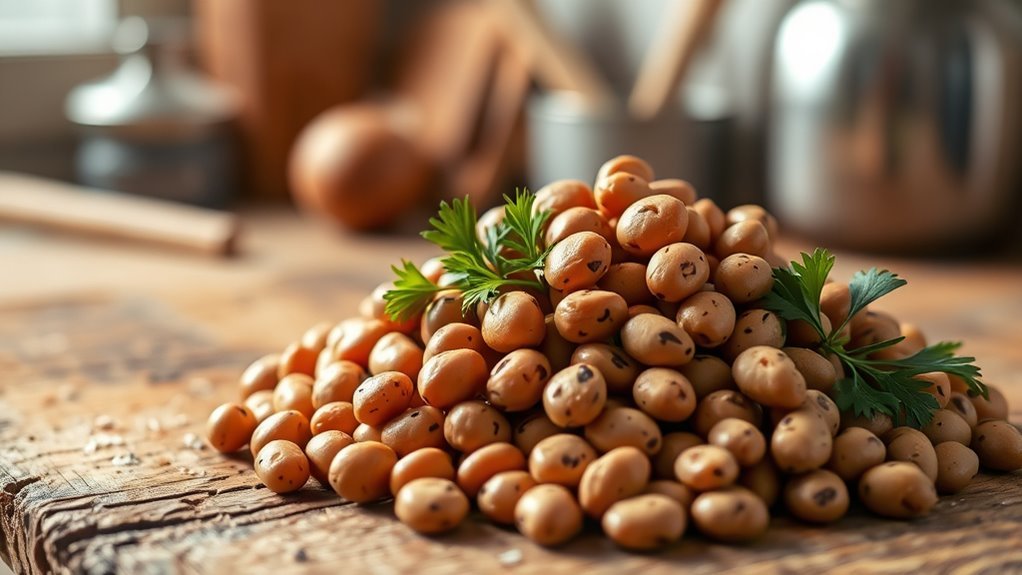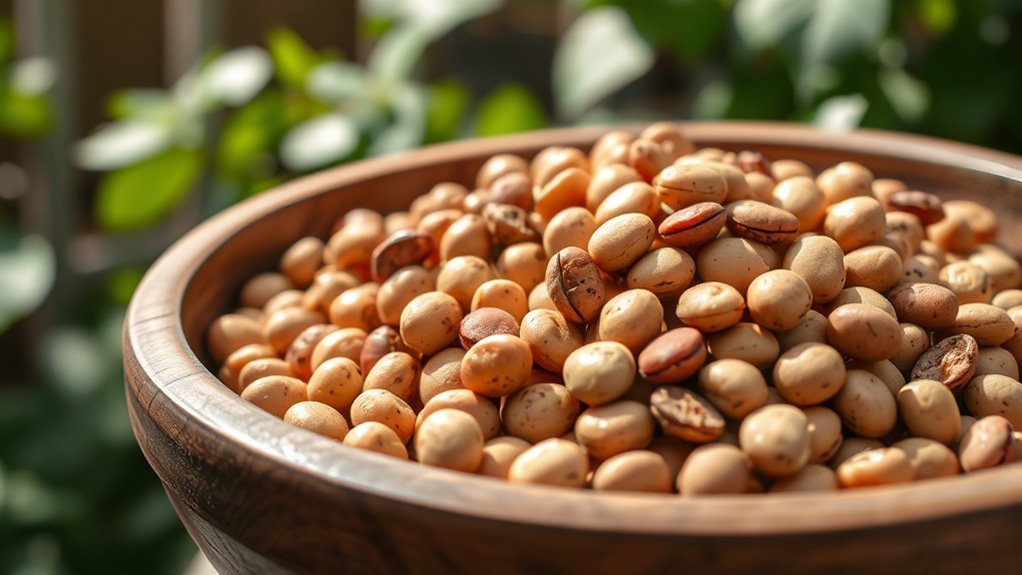Pinto beans aren’t typically considered keto-friendly due to their higher carbohydrate content, with around 18g of net carbs per 100g. While they’re packed with protein, fiber, and essential nutrients, portion control is key if you’re trying to stick to a keto diet. Mixing pinto beans with non-starchy vegetables and healthy fats can create balanced meals. If you’re interested in exploring better alternatives and meal tips, there’s more information ahead.
Nutritional Profile of Pinto Beans

Pinto beans are a popular legume known for their creamy texture and versatility in various dishes. They provide numerous pinto bean benefits, making them an excellent addition to your diet. Rich in protein, fiber, vitamins, and minerals, they support digestive health and keep you feeling full longer. Incorporating pinto beans into your meals can also help stabilize blood sugar levels. You can explore a variety of pinto bean recipes, from classic chili to hearty bean salads, ensuring you enjoy their nutritional perks without sacrificing flavor. Plus, they’re budget-friendly and easy to prepare, fitting perfectly into a healthy, freedom-loving lifestyle. So, whether you’re cooking for yourself or friends, pinto beans can be a delicious and nutritious choice.
Carbohydrate Content: A Closer Look

When considering pinto beans in a keto diet, it’s essential to examine their carbohydrate content. You’ll want to compare their total carbs to fiber and net carbs, as fiber can mitigate the overall impact on your carb intake. Additionally, portion control plays a significant role in how pinto beans fit into your daily carb limits.
Carb Count Comparison
While beans are often praised for their nutritional benefits, their carbohydrate content can be a concern for those following a ketogenic diet. Here’s a quick comparison of pinto bean varieties and their carb counts to help you navigate your options:
| Bean Variety | Net Carbs per 100g |
|---|---|
| Pinto Beans | 27g |
| Black Beans | 23g |
| Kidney Beans | 22g |
If you’re looking for keto-friendly recipes, consider using smaller portions or pairing them with low-carb ingredients. While pinto beans are versatile and can add flavor to your meals, it’s essential to be mindful of their carb content to maintain your ketogenic goals. Balancing flavors and nutrients is key to enjoying your meals without compromising your diet.
Fiber vs. Net Carbs
Understanding the balance between fiber and net carbs is essential for anyone considering pinto beans on a ketogenic diet. Pinto beans are a rich fiber source, which can be beneficial for digestion and overall health. When counting carbs, it’s important to focus on net carbs—total carbs minus fiber. This distinction allows you to enjoy beans without exceeding your carb limits. Pinto beans contain about 27 grams of total carbs per cooked cup but also provide around 9 grams of fiber, resulting in approximately 18 grams of net carbs. By practicing carb awareness, you can incorporate pinto beans into your meals while still adhering to your keto goals. Emphasizing fiber sources in your diet supports both health and freedom in your food choices.
Portion Control Importance
As you explore the role of pinto beans in your ketogenic diet, it is crucial to take into account portion control due to their carbohydrate content. Pinto beans contain around 27 grams of carbs per cup, which can quickly add up and impact your daily limit. By practicing mindful eating, you can enjoy their nutritional benefits while staying within your carb goals. Consider smaller portion sizes, such as half a cup, which provides fiber and protein without overwhelming your carb count. Balancing pinto beans with low-carb vegetables or proteins can help you maintain the freedom of choice in your meals while adhering to your keto lifestyle. Remember, moderation is key to successfully integrating pinto beans into your diet.
Fiber vs. Net Carbs: Understanding the Difference

When you’re tracking your carb intake on a keto diet, understanding the difference between fiber and net carbs is vital. Fiber plays an essential role in digestion and can be subtracted from total carbs to calculate net carbs, which may impact your state of ketosis. By grasping these concepts, you can make more informed choices about foods like pinto beans.
Fiber’s Role in Nutrition
While many people focus on total carbohydrate intake when following a keto diet, the role of fiber often gets overlooked. Fiber is essential for maintaining good digestive health and can provide several benefits that contribute to overall well-being. Understanding fiber’s role can help you make informed dietary choices. Here are some key fiber benefits to take into account:
- Supports Digestive Health: Promotes regular bowel movements and prevents constipation.
- Blood Sugar Control: Helps stabilize blood sugar levels by slowing down digestion.
- Weight Management: Increases satiety, making you feel fuller for longer.
- Heart Health: Lowers cholesterol levels and reduces the risk of heart disease.
Incorporating various fiber sources into your daily intake can enhance your keto experience while supporting your health goals.
Calculating Net Carbs
Understanding how to calculate net carbs is essential for anyone following a keto diet, particularly when distinguishing between total carbohydrates and fiber. Net carbs are calculated by subtracting fiber from total carbs, as fiber isn’t digested and doesn’t raise blood sugar levels. For pinto beans, knowing their net carb content can help you decide if they fit your keto plan.
| Food Item | Total Carbs (g) | Fiber (g) | Net Carbs (g) |
|---|---|---|---|
| Pinto Beans | 27 | 9 | 18 |
| Almonds | 22 | 12 | 10 |
| Broccoli | 7 | 3 | 4 |
| Cauliflower | 5 | 2 | 3 |
Impact on Ketosis
The impact of fiber and net carbs on ketosis is essential to grasp for anyone adhering to a keto diet. Understanding the difference can help you manage your ketosis effects effectively. Here are some key points:
- Fiber content: High-fiber foods, like pinto beans, can aid digestion and may not spike blood sugar.
- Net carbs: Calculating net carbs involves subtracting fiber from total carbs, providing a clearer picture of what you consume.
- Keto-friendly alternatives: Consider pinto bean alternatives such as zucchini or cauliflower for lower net carb options.
- Balance: Aim for a well-rounded diet that includes fiber while keeping net carbs low to maintain ketosis.
The Role of Legumes in a Ketogenic Diet
Although legumes are often praised for their nutritional benefits, their role in a ketogenic diet can be somewhat controversial. Many legume varieties, like lentils and chickpeas, are higher in carbohydrates, which can hinder your progress toward ketosis. If you’re managing dietary restrictions, it’s essential to evaluate how these foods fit into your macros. While some people find that small portions of legumes don’t disrupt their ketosis, others may experience challenges. Balancing your carb intake with protein and healthy fats is vital on a keto plan. Ultimately, it’s about finding what works for you. If you choose to include legumes, moderation is key, and always track your daily carbohydrate intake to stay aligned with your ketogenic goals.
Health Benefits of Pinto Beans
Pinto beans, while often debated in the context of a ketogenic diet, offer a range of health benefits that can be appealing for those who include them in their meals. Here are four key advantages:
- Protein Source: Pinto beans are a great plant-based protein source, essential for muscle recovery and overall health.
- Nutrient Density: They’re packed with vitamins and minerals, providing substantial nutrition with relatively few calories.
- Digestive Health: High in fiber, pinto beans support digestive health, helping to regulate bowel movements.
- Heart Health & Blood Sugar: Their antioxidant properties promote heart health and help stabilize blood sugar levels, making them beneficial for weight management.
Incorporating pinto beans into your diet can be a tasty way to enjoy these health advantages!
Alternatives to Pinto Beans on Keto
When you’re following a ketogenic diet, finding suitable alternatives to pinto beans can be essential for maintaining your carb limits while still enjoying nutritious meals. Luckily, there are several low carb alternatives that not only satisfy your hunger but also provide high fiber options.
| Alternative | Net Carbs (per 100g) | Fiber (per 100g) |
|---|---|---|
| Black Soybeans | 1.5g | 9g |
| Zucchini Noodles | 3g | 2g |
| Cauliflower Rice | 3g | 2g |
| Lentils (in moderation) | 20g | 8g |
Incorporating these options can help you stay on track with your keto goals while enjoying a variety of flavors and textures in your meals.
Incorporating Pinto Beans in Moderation
While it’s important to stay within your carbohydrate limits on a ketogenic diet, incorporating pinto beans in moderation can still offer nutritional benefits. Here are some ways to enjoy pinto beans while sticking to keto-friendly meals:
Incorporating pinto beans in moderation can provide nutritional benefits while adhering to your ketogenic diet.
- Portion Control: Use small servings to keep your carb intake in check.
- Mix with Low-Carb Ingredients: Combine pinto beans with non-starchy vegetables for balanced pinto bean recipes.
- Add Healthy Fats: Include avocados or olive oil to boost the meal’s fat content.
- Pair with Protein: Serve pinto beans alongside lean meats or fish to create a satisfying dish.
Tips for Meal Planning With Pinto Beans
Incorporating pinto beans into your meal planning can be a smart way to add variety and nutrition to your diet, especially if you’re mindful of carbohydrate intake. For effective meal prep, consider cooking a large batch of pinto beans at once. This saves time and allows you to portion sizes that fit your dietary needs. You can then use them in salads, soups, or as a side dish throughout the week. Keep in mind that while pinto beans are nutritious, moderation is key. Aim for balanced meals by combining them with low-carb vegetables and healthy fats. Always adjust portion sizes based on your individual goals, ensuring you enjoy the benefits without compromising your keto lifestyle.
Final Thoughts on Pinto Beans and Keto
Pinto beans can be a nutritious addition to many meals, but if you’re following a keto diet, it’s important to reflect on their carbohydrate content. While they offer protein and fiber, their carb count may hinder your progress. Consider these points:
- Carbohydrate Count: Pinto beans are relatively high in carbs, which can disrupt ketosis.
- Portion Control: If you choose to include them, monitor your serving size carefully.
- Pinto Bean Alternatives: Explore options like black soybeans or lentils, which can be lower in carbs.
- Keto Friendly Legumes: Look for legumes that align better with your dietary goals, such as green beans or snow peas.
Ultimately, balancing your meals with low-carb options will help you stay on track.


